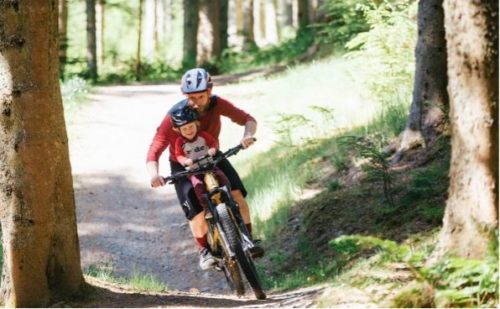Families can spend quality time together in the great outdoors, benefiting from cycling. However, without the proper gear, riding a bike with a child can be difficult. This is where protective bike seats for kids come in handy. The purpose of these seats is to provide a secure and comfortable ride for children while out on their parents’ bikes. Read this post to learn about the various seat options so you can choose the one that’s best for your family. We’ll also go over some strategies for making family bike trips less stressful and more fun for everyone. Let’s dive in!
Types of Bike Seats
Front-Mounted Child Bicycle Seats
Biking parents can take their kids for a spin with the help of front-mounted seats. They are suitable for children from 9 months to 3 years old. These seats attach to the front of the bike and make it simple for parents to talk to their kids as they ride.
The rider can maintain more stable footing thanks to the seat’s location in the front of the bike. The extra load in the front of the bike improves the bike’s center of gravity. It can keep the bike from tipping over. When traveling over rough terrain, this can be especially useful.
Please be aware that not all bikes can accommodate the type of seats. The bike’s frame must be well-made and feature a top tube that is perpendicular to the ground. Check the manufacturer’s specifications to make sure it will fit your bike. You can read additional information at https://threo.co.uk/product/front-mounted-child-bike-seat.
Rear-Mounted Seats
Children from 9 months to 6 years old can use the rear-mounted seats that attach to the back of an adult’s bike. When properly installed, rear-facing seats provide a great deal more back support and comfort for the kid. A child’s head and body are better supported by the high backrest and shoulder harness. In addition to the obvious safety benefits, these seats also provide the parent with more space to stretch out their legs. Some models even have perks like reclining positions and movable footrests. When traveling for extended periods, this can be a welcome relief.
The restricted perspective of the kid is one of the major drawbacks. There’s a chance the child won’t get a good look at their surroundings if they’re sitting behind mom or dad. A solution is to take frequent breaks and let the kid out of the seat to run around and play. This extra mass also increases the bike’s rear-end balance. The bike may feel less steady as a result, especially on rougher surfaces. Make sure it is securely fastened and your body weight is distributed properly across the bike.
Overall, seats in the front of the bike offer better visibility and accessibility for interacting with your child, while seats in the back provide more back support.
Trailers
Children aged 1 to 6 can ride safely and comfortably in trailers. They are designed to attach to the bike’s rear and offer a private space. The increased storage capacity is one of the most significant benefits. When compared to the space available in the front and back seats, trailers are ideal for transporting bulky items like food, beverages, and spare clothing.
The comfort of the child is increased in trailers, which is yet another benefit. The kid has been protected from the shocks and vibrations of the road thanks to the vehicle’s suspension system.
On the other hand, the extra bulk and size are one of the major drawbacks. Because of this, negotiating sharp turns and narrow passages can be challenging. The trailer’s built-in safeguards should also be given a serious thought. There needs to be a safe and convenient system for attaching it to your bike. You should also use reflective tape and paint your trailer a bright color so that it stands out on the road.

How to Choose the Best Bike Seat
- Seats should be selected according to the child’s age and weight. Infants younger than 9 months old should not use bike seats. In most cases, you should wait until your child can sit up straight with no support from you before putting them in a seat;
- Seats with adjustable harnesses, foot straps, and high backs are preferable for safety;
- Always use a helmet, ride within the law, and check that the seat is fastened securely to the bike;
- Check the seat’s dimensions against those of your bike’s frame to ensure a snug fit;
- Select a seat that offers both support and flexibility, such as a footrest and a mechanism that allows you to recline;
- Consider how simple it will be to put in, take out, and clean the seats you’re considering.
How to Make Family Bike Rides Less Stressful
- Start slow with short rides to get your child comfortable with the bike’s seat and the cycling experience;
- Obey traffic laws to protect yourself and others;
- Be sure to pack some snacks and water for the kids, as they are likely to get hungry and thirsty while out on their bikes;
- In case the weather changes suddenly, it is a good idea to bring along a small first-aid kit, some sunscreen, and an extra set of clothes;
- Make it a positive experience by pointing out landmarks and initiating conversation with your child.
Conclusion
In conclusion, using a bike seat is a wonderful way to bond with your kid. Think about your child’s age and size, as well as the seat’s safety features, compatibility, comfort, and ease of use when making your selection. Be patient, put safety first, and try to make it fun for your kid. You can make family bike rides more fun with the advice provided here. We wish you safe travels.

